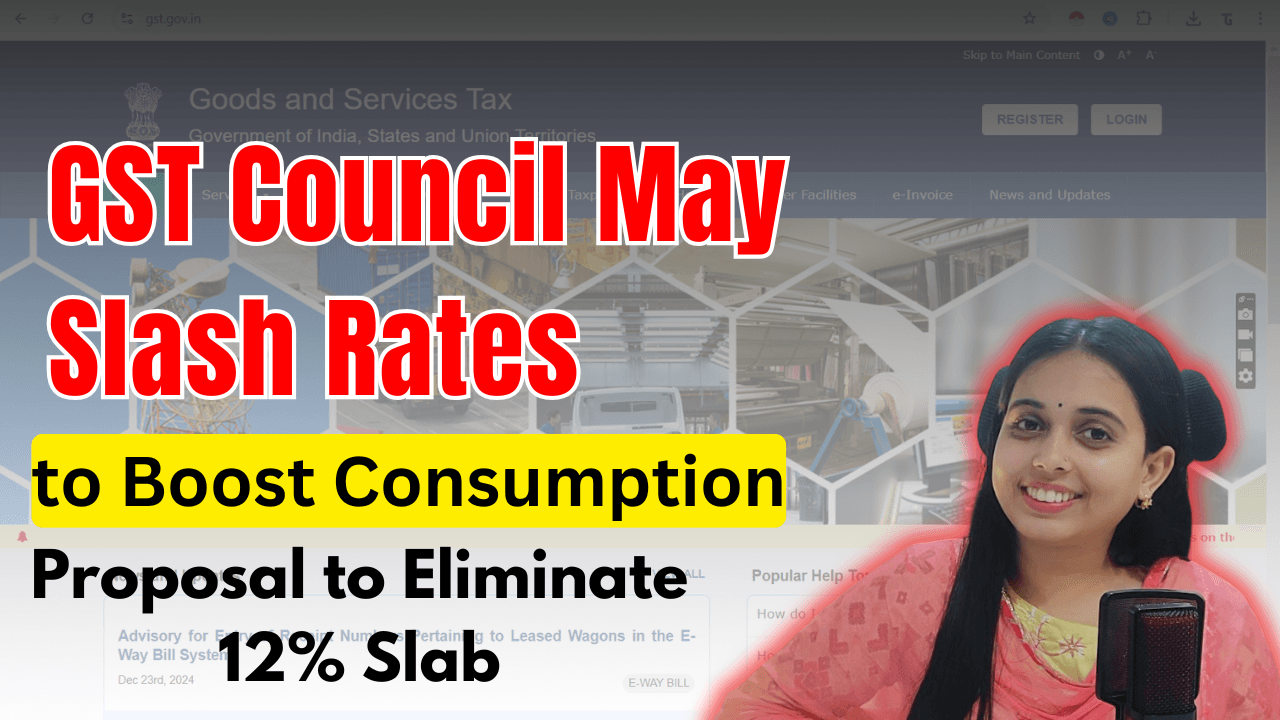GST Council May Slash Rates to Boost Consumption
In a significant move to boost consumption and simplify the tax structure, the GST Council is reportedly considering slashing rates and scrapping the 12% tax slab altogether. This proposal is part of an effort to simplify the Goods and Services Tax (GST) structure, making it easier for businesses to comply while encouraging consumer spending.
According to a report by Mint, the council is reviewing the possibility of shifting items currently under the 12% slab to either 5% or 18%, depending on the nature of the goods and services. The proposal is still under discussion, with a final decision expected soon.
What’s Being Proposed?
The GST system in India currently has four primary tax slabs—5%, 12%, 18%, and 28%. The proposal aims to reduce the number of slabs by eliminating the 12% slab and redistributing items under it to either the 5% or 18% categories.
- Items shifting to 5%: Consumers may see a price reduction on essential items currently taxed at 12%.
- Items moving to 18%: Non-essential or luxury items may face a higher tax rate.
The Chaudhary ministerial panel, which was established in September 2021, is tasked with reviewing tax anomalies and simplifying the GST structure. The focus has now shifted from mere revenue enhancement to stimulating consumption as well.

Why Is This Change Important?
- Simplification of the Tax System
- Reducing the number of tax slabs will streamline compliance and reduce classification disputes.
- Businesses will find it easier to categorize products, leading to fewer errors and disputes during GST filings.
- Boosting Consumption
- Lowering tax rates on select goods will make them more affordable for consumers.
- Higher consumption will help revive demand across key sectors like FMCG, real estate, and consumer durables.
- Revenue Neutral Approach
- The council aims to balance tax cuts with the need for sufficient revenue collection by adjusting the rates smartly.
- This approach ensures that while consumption increases, there is no significant dip in overall GST collections.
GST Slab Distribution: Current Status
As of April 2023, the distribution of items across GST slabs is as follows:
| GST Slab | Number of Items | Examples of Goods/Services |
| 5% | 280 | Packaged food, life-saving drugs, fertilizers |
| 12% | 275 | Processed food, footwear between ₹1,000-₹2,500, hotel rooms under ₹1,000 |
| 18% | 600+ | Soap, toothpaste, electronics, home appliances |
| 28% | <50 | Luxury goods like cars, tobacco, and aerated drinks |
The proposal to eliminate the 12% slab will shift these items either to the 5% or 18% category, depending on their classification as essential or non-essential.
Revenue Trends and Impact
India’s GST collections have shown a steady increase over the years, indicating a robust compliance environment. In January 2025, GST collections reached ₹1.71 trillion, marking the highest collection in nine months. The record collection stands at ₹1.92 trillion in April FY25.
The Fifteenth Finance Commission, chaired by N.K. Singh, previously recommended transitioning from the current four-slab structure to a three-tier system, citing the need for simplification and revenue stability.
What Does This Mean for Businesses and Consumers?
For Businesses:
- Simplified Compliance: Easier classification of products will reduce errors and compliance costs.
- Impact on Margins: Businesses selling goods currently in the 12% slab may experience changes in pricing strategies based on the new slab they fall under.
For Consumers:
- Lower Prices on Essentials: Goods moving from 12% to 5% will become more affordable, increasing purchasing power.
- Potential Price Increase on Certain Goods: Items moving to the 18% slab may become more expensive, affecting demand for non-essential products.
For the Economy:
- Consumption Boost: Reduced prices on key goods will encourage spending, especially in sectors like FMCG and retail.
- Improved Revenue Collection: Simplified slabs may lead to better compliance and reduced tax evasion, ultimately benefiting the government’s revenue.
Conclusion
The proposal to scrap the 12% GST slab and shift items to the 5% or 18% categories is a bold step toward simplifying the GST structure and driving consumption growth. While the move promises to reduce compliance burdens and stimulate demand, its success will depend on how the items are reclassified and the timing of its implementation.
Businesses and consumers must stay updated on these changes to understand how they will impact pricing, costs, and consumption patterns.
Stay Updated!
For the latest updates on GST changes and how they affect your business, follow our blog and subscribe to Taxgyany on YouTube for simplified explanations of complex tax concepts.
For More Information : https://taxgyany.com/

